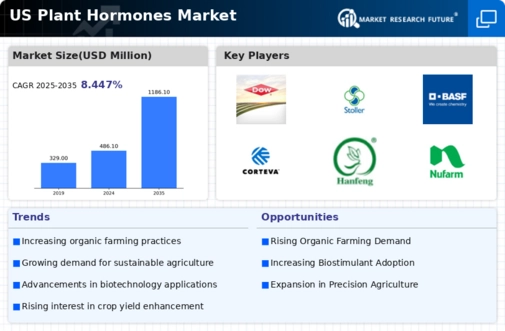The US Plant Hormones Market has been experiencing notable competitive dynamics characterized by advancements in agricultural practices and an increasing emphasis on sustainable farming solutions. This market comprises various plant growth regulators, including auxins, gibberellins, and cytokinins, which are widely utilized to enhance crop yield, quality, and production efficiency. Key players in this landscape are actively engaging in research and development to innovate their product offerings and cater to the diverse needs of farmers. Increased demand for organic and environmentally friendly agricultural practices has led to a surge in the adoption of plant hormones, thus intensifying competition among stakeholders.
Understanding the market's competitive landscape is crucial for industry participants to capitalize on emerging opportunities, address challenges, and formulate strategic initiatives for growth.FMC Corporation has established a strong foothold in the US Plant Hormones Market, showcasing its commitment to delivering innovative agricultural solutions. The company is recognized for its extensive portfolio of crop protection products that leverage plant hormones to enhance plant growth and productivity. FMC Corporation's strengths lie in its robust research and development capabilities, which facilitate the continuous introduction of advanced formulations that meet the evolving demands of the agricultural sector.
Additionally, the company has formed synergistic collaborations with agricultural partners, allowing it to effectively penetrate the market and expand its distribution network. Through its strategic focus on sustainability, FMC Corporation is positioned to cater to the growing preference for eco-friendly agricultural practices among US farmers, reinforcing its competitive edge in the plant hormones segment.Dow AgroSciences plays a significant role in the US Plant Hormones Market, leveraging its expertise in agricultural science to provide a comprehensive range of products and services designed to optimize plant health and productivity.
The company is well-known for its effective plant growth regulators that promote enhanced crop yields and resilience against environmental stressors. With a focus on innovation, Dow AgroSciences has consistently introduced cutting-edge solutions to address specific agricultural challenges, solidifying its presence in the market. The company has also engaged in strategic mergers and acquisitions, enabling it to expand its product offerings and enhance its market share within the US region.
Its commitment to sustainability and responsible agricultural practices resonates well with farmers seeking to adopt more environmentally friendly cultivation methods, establishing Dow AgroSciences as a key player in the competitive landscape of plant hormones in the United States.




















Leave a Comment